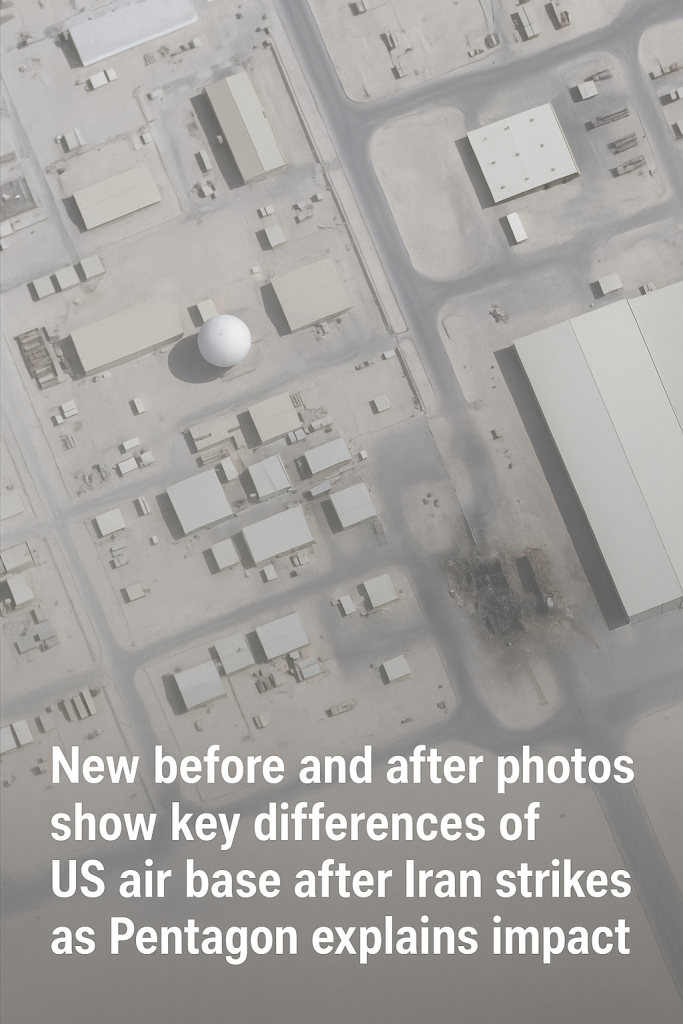Recent before-and-after images of a US air base targeted by Iran’s missile strikes have surfaced, revealing significant changes to the facility and prompting detailed explanations from Pentagon officials about the strike’s impact. The visuals provide a rare glimpse into the immediate physical aftermath of the attack, offering the public a clearer understanding of what transpired in this high-stakes military confrontation.
The Attack and Its Context
Earlier this year, Iran launched a series of missile strikes on a US air base located in the Middle East, escalating tensions in an already volatile region. The strikes were reportedly in retaliation for previous US military actions and aimed to send a clear message of deterrence. The Pentagon quickly assessed the damage and deployed teams to evaluate operational readiness and ensure the safety of all personnel on the ground.
Visual Proof of the Damage
The newly released images show the stark contrast between the air base’s condition before and after the missile strikes. Prior to the attack, the base was pristine, with orderly rows of aircraft, intact facilities, and meticulous infrastructure. The aftermath photos tell a different story: large craters pockmark the runway, several buildings show structural damage, and scattered debris indicates the force and precision of the impact.
One of the most striking alterations is the visible damage to tactical aircraft hangars and support buildings, hinting at both immediate destruction and ongoing repair needs. Officials emphasize, however, that the damage, while significant, did not compromise critical operational capabilities.
Pentagon’s Explanation and Assurance
In a detailed statement, Pentagon representatives confirmed that while the attack caused measurable damage, all US forces stationed at the air base were unharmed. The military stressed that the base remains fully operational and that contingency plans were effectively implemented to mitigate the strike’s impact.
“The resilience and preparedness of our personnel and infrastructure have ensured that mission readiness is maintained,” a defense official stated. The Pentagon also underlined its continued commitment to monitoring the region closely and responding swiftly to any further threats.
Implications for Regional Stability and US Strategy
These visual proofs and official confirmations carry broader implications beyond the immediate damage. The photographs underscore how advanced missile technology, deployed with precision, can alter the physical landscape of military installations and test the robustness of defense systems. At the same time, the Pentagon’s response highlights the importance of rapid assessment and repair capabilities in maintaining a credible deterrent posture.
Analysts interpret this episode as a warning shot, reflecting heightened tensions between the US and Iran but also showcasing the measures both sides are prepared to implement in this ongoing strategic contest.
Public and Global Reaction
The release of these images has sparked widespread discussion on social media and among defense circles. Many expressed surprise at the visible damage, calling the before-and-after comparisons “eye-opening” and a “wake-up call” on the realities of modern warfare in contested zones. The clear documentation of the aftermath supports calls for continued vigilance and strategic dialogue to prevent escalation.
As the situation continues to develop, the Pentagon’s transparency in sharing these images and explanations contributes to a better-informed public discourse on military readiness and geopolitical risk in one of the world’s most complex regions.
In Summary
The striking before-and-after photos of a US air base impacted by Iran’s recent missile strikes offer concrete evidence of the physical and strategic effects of the attack. Coupled with Pentagon assurances of operational resilience, these visuals deepen our understanding of the evolving security dynamics in the Middle East. With ongoing tension, both sides remain watchful



